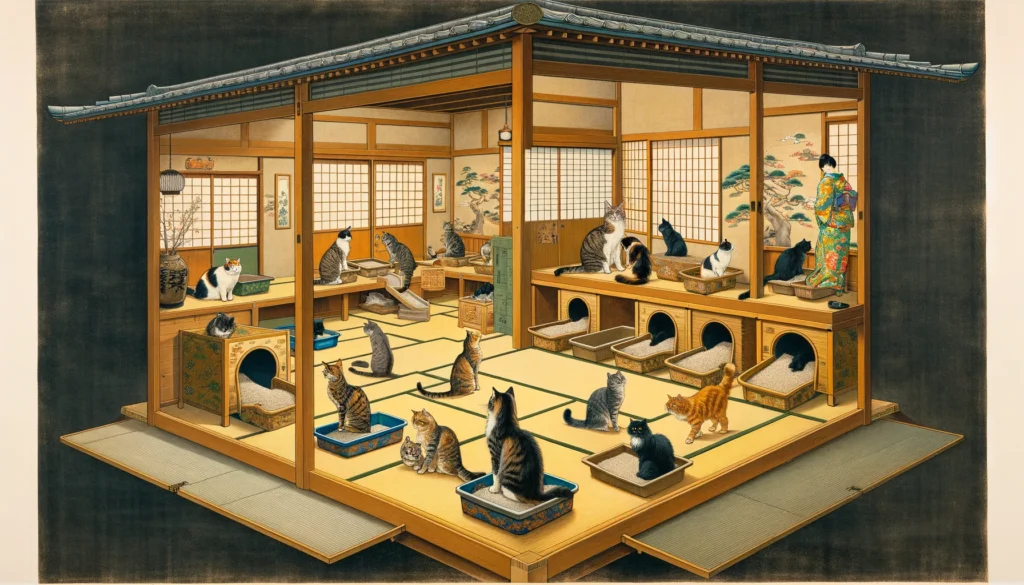If you’ve ever tried to keep the peace among multiple cats under one roof, you know it’s not always as easy as it sounds. Sure, they might cuddle together on your favorite chair when you’re not looking, but when it comes to the litter box, their politeness can go right out the window. That’s where Multi-Cat Household Litter Box Training Strategies come in. With a few thoughtful steps and the right mindset, you can help all your cats learn to share (or at least coexist) in litter box harmony.
- Why Multi-Cat Litter Box Training Is Different
- How Many Boxes Do You Really Need?
- Location, Location, Location
- Choosing the Right Type of Box
- Picking the Perfect Litter
- Training New Arrivals
- Reinforcing Good Behavior
- Maintenance Matters
- Handling Conflicts and Stress
- A Personal Anecdote
- Further Reading
- FAQs on Litter Box Training in Multi-Cat Households
- The Takeaway
Why Multi-Cat Litter Box Training Is Different
Training one cat to use a litter box usually involves a straightforward process: show them where the box is, keep it clean, and let their natural instincts do the rest. But when you add another cat (or two or three) to the mix, things get more complicated. Cats are territorial by nature, and some may view the litter box as prime real estate.
Instead of thinking, “Oh good, a clean place to go,” they may think, “This box is mine, and you better not even think about using it.” This can lead to conflicts, spraying, or your cats choosing an unwanted spot for their business—like your closet floor. By tailoring your approach to litter box training for multiple cats, you can minimize these issues and create a peaceful environment for everyone.

You May Also Like: 5 Amazing Tips on how to train an outdoor cat to use a litter box
How Many Boxes Do You Really Need?
One of the most common pieces of advice from behavior experts is to have at least one box per cat, plus an extra. For example, if you have two cats, aim for three boxes. Three cats? You’re looking at four boxes. It might seem like a lot, but having several cat litter stations reduces competition. Each cat knows there’s always another option if one box is occupied or if they just don’t like the vibe of a particular spot.
Remember, quantity alone won’t solve the problem if the boxes are all bunched together. Spreading them out around your home ensures there’s no single “hot spot” that a dominant cat can guard.
Location, Location, Location
Just like in real estate, location matters when it comes to litter boxes. You wouldn’t want to eat in a crowded closet or try to relax in a noisy hallway, right? Cats feel the same way. Place boxes in quiet, low-traffic areas where your cats won’t feel trapped or startled. Avoid putting all the boxes in one room. Instead, disperse them throughout the house. Consider a box in a spare bedroom, another in a quiet corner of the living room, and maybe one near (but not too close to) the kitchen.
Also, think about accessibility. If you live in a multi-story home, keep at least one box on each floor. This prevents cats from having to hike up and down stairs when nature calls, which can be a real turn-off for older or more timid cats.
Choosing the Right Type of Box
Not all litter boxes are created equal. Some cats love a covered box for the privacy it offers, while others feel trapped and prefer an open box. With multiple cats, it’s often best to provide a mix of box types. This ensures each cat can find a box that suits their style.
For instance, if you notice one cat always choosing the open box in the basement while another favors the covered box in the hallway, that’s a clue that variety can help maintain harmony. Experiment to find the perfect setup for your group.
Picking the Perfect Litter
Cats can be picky about cat litter, and if they don’t like the texture or smell, they might find somewhere else to go. Generally, unscented, clumping litter works well because it feels good on their paws and is easy for you to clean. Avoid heavily scented litters, which can be off-putting to cats and cause them to associate the box with unpleasant smells.
If one of your cats seems reluctant to use a certain box, consider switching up the litter in that box to see if it makes a difference. Just remember to transition slowly—mixing new litter in with the old, bit by bit—to avoid shocking your cats with a sudden change.
Training New Arrivals
When a new cat joins your family, don’t just plop them in the living room and hope they figure things out. Take a more structured approach. Start by confining them to a smaller, quiet space (like a bedroom) with their own litter box. This helps them build a positive association with the box before they have to navigate the rest of the house and meet the other cats.
Over time, gradually expand their territory. Introduce them to the existing cats slowly and supervise their interactions. Each cat should have easy access to at least one box that feels like “theirs.” This way, the new cat learns good habits right from the start, and the established cats have time to adjust without feeling like their space is invaded.
Reinforcing Good Behavior
When you see one of your cats using the litter box properly, give them some positive reinforcement. You don’t need to throw a party—but a gentle scratch behind the ears and a calm, kind word can go a long way. Cats may not respond to praise like dogs, but they can still pick up on the positive energy and relaxed attitude you have when they’re doing what you want.
If you catch a cat going outside the box, don’t yell or punish them. This can create negative associations with the litter box and make the problem worse. Instead, calmly clean up the mess and take a look at your setup. Is the box clean enough? Is there enough privacy? Maybe it’s time to add another box or change the location.

Maintenance Matters
No matter how perfect your setup is, you won’t get far if you let the boxes get dirty. Cats have a keen sense of smell, and many will refuse to use a box that isn’t clean. Scoop at least once or twice a day, and do a full litter change and box scrub every few weeks. A clean box not only makes the cats happier, but it also makes your life easier. Regular maintenance prevents accidents, reduces odors, and helps maintain a peaceful environment.
Handling Conflicts and Stress
Sometimes, even the best Multi-Cat Household Litter Box Training Strategies need a little extra help. If you notice ongoing conflicts or one cat consistently blocking another from using a box, you might need to get creative. Try adding vertical space (like cat trees or shelves) so that more timid cats can perch above the action. Consider using pheromone diffusers that can help reduce stress and tension in the home. If things get really tough, consult with a veterinarian or animal behaviorist. They can offer personalized solutions and help you restore harmony.
A Personal Anecdote
I once had a friend who inherited a second cat from a family member who could no longer care for it. Her original cat was a calm, older gentleman, while the newcomer was a feisty young female who seemed to think she owned the place. As soon as the newbie arrived, my friend noticed accidents around the house.
By placing an additional litter box in a secluded corner of her spare room and switching to a softer, unscented litter in that new box, the younger cat started using it right away. The older cat stuck to his preferred box in the kitchen. Over time, as the two got used to each other, my friend gradually moved the new box closer to the main living area. In a few weeks, both cats were comfortably sharing multiple boxes without drama. It was a simple fix that helped everyone get along.
Further Reading
FAQs on Litter Box Training in Multi-Cat Households
Q: What’s the litter box rule for many cats?
A: The rule is to have one litter box per cat, plus one extra, to prevent competition and stress among cats.
Q: How can you make all your cats use the litter box?
A: Introduce each cat to the litter box individually and maintain cleanliness to encourage its use.
Q: What’s the best way to handle litter in a house with lots of cats?
A: Regular cleaning and having multiple litter boxes help manage litter effectively in multi-cat homes.
Q: Where should you place litter boxes in a house with many cats?
A: Place litter boxes in quiet, accessible locations throughout the home, avoiding high-traffic areas.
Q: Is it cool for three cats to share one litter box?
A: No, it’s recommended each cat has its own litter box to avoid conflicts and hygiene issues.
Q: Do cats living together need one litter box each?
A: Yes, each cat should have its own litter box to ensure they feel safe and comfortable.
Q: Can you place two litter boxes right next to each other?
A: It’s better to spread them out to give your cats more options and privacy.
Q: What mistakes do people make that make cats not use the litter box?
A: Not cleaning the litter box regularly and placing it in noisy areas can discourage cats from using it.
Q: Is an open or closed litter box better?
A: It depends on your cat’s preference; some like the privacy of a closed box, while others prefer the openness of an uncovered one.
Q: Is having two litter boxes okay for three cats?
A: It’s better to have at least one box per cat, so for three cats, three boxes are ideal to prevent issues.
Q: How many litter boxes are needed for three cats?
A: You should have at least four litter boxes for three cats to ensure there are enough options for all.

The Takeaway
When it comes to multi-cat households, planning and patience pay off. By focusing on these Multi-Cat Household Litter Box Training Strategies, you can make your home a more peaceful, harmonious place:
- Offer Plenty of Options: More boxes than cats helps reduce competition.
- Choose Good Locations: Spread boxes around the house, ensuring privacy and easy access.
- Mix It Up: Provide different box styles and cat litter types to keep everyone happy.
- Stay Clean: Keep the boxes tidy to encourage consistent use.
- Introduce Changes Slowly: Whether it’s a new cat or new litter, gradual adjustments prevent feline freak-outs.
With a little effort, you can help your cats comfortably share their bathroom space. After all, a happy cat means a happier home. And who wouldn’t want that?


